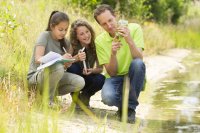Teaching Climate Change Across Subjects
Teachers in diverse disciplines—such as environmental science, language arts, and social studies—are covering climate change.
Your content has been saved!
Go to My Saved Content.When Hurricane Harvey hit the Houston area in August 2017, a new school year was just hours away from starting in the Humble Independent School District. Within a two-day period, more than four feet of rain inundated the region, flooding thousands of homes, businesses, and one of the district’s largest high schools.
Overnight, climate change was no longer theoretical. “It’s right here,” says Kathleen Goerner, coordinator of secondary science for Humble ISD. “Hurricane Harvey was extraordinary,” she adds, “but that’s the point. Climate change means you do have extreme weather events and rising sea levels.”
After the floodwaters receded, educators recognized an opportunity for real-world learning. Instead of reverting to traditional lessons, teachers created project-based learning (PBL) units that focus on the health and restoration of the Lake Houston Watershed. “Sure, teachers have taught [about] watersheds before,” says Goerner, who has been coaching a cohort of 18 teachers on PBL design, “but never with such a connection to our local geography.” And never with students’ own stories so integral to the learning experience. “That’s been riveting,” Goerner adds.
A World of Learning Opportunities
Across the country, teachers in diverse disciplines—from environmental science to language arts to social studies—are bringing climate change into the curriculum. Fortunately, it doesn’t take a hurricane, wildfire, or flood to make the subject meaningful by connecting it to students’ lives.
In California’s Marin County, middle school teacher Rebecca Newburn wants her students to understand both the science and the urgency of climate change. “Human impact [on climate] is a big takeaway,” she says, underscored everywhere from the Next Generation Science Standards to the recently released Fourth National Climate Assessment written by 300 experts from government agencies, industry, academia, tribal organizations, and nongovernment organizations.
Newburn wants students to come away from learning experiences as informed citizens who are prepared to take action. As she asks, “How can they feel empowered to make a difference?” That theme recurs in PBL units that put students in the role of citizen scientists. Newburn’s most recent project, Drawdown: Climate Action Now!, engages students in data analysis as they develop plans to track and reduce their carbon emissions. It was inspired in part by Drawdown, an ambitious plan to reverse climate change edited by Paul Hawken.
“This idea of drawdown made me think we need to go beyond the standards of mitigation to reversing global warming,” Newburn explains.
Science teachers interested in designing similar projects will find a wealth of online resources, including NASA Climate Kids, NOAA Climate, and Bill Nye the Science Guy’s Climate Change 101 video.
For a compelling entry event to a project, teachers might consider sharing examples of what other young people are doing in response to climate change, such as the story of a 15-year-old climate activist from Sweden named Greta Thunberg.
“Cli-Fi” and More in Language Arts
Opportunities to study climate change go far beyond science classes. Literacy and imagination are powerful tools for tackling this complex subject, according to the authors of Teaching Climate Change to Adolescents: Reading, Writing, and Making a Difference.
Authors Richard Beach, Jeff Share, and Allen Webb describe how English language arts teachers are approaching climate change as a story, complete with multiple points of view, compelling characters, plot twists, moral questions, and issues of fairness. To develop understanding, students can explore nonfiction sources or analyze dystopian novels and the “cli-fi” (climate fiction) genre to gain insight from other perspectives. Students become content creators when they produce multimedia stories to imagine alternative visions, educate communities, or advocate for change.
The book includes examples from a wide range of grade levels and contexts. A high school teacher, for example, describes how students analyzed short stories (such as Margaret Atwood’s “Time Capsule Found on the Dead Planet”) and informational texts to prepare for Socratic seminars about human responsibility for the planet. Other teachers have used drama, gaming, and civic action projects that connect with the larger community.
Along with the plentiful resources and examples featured in the book, the authors maintain an online site with additional activities and links.
Tools for Geographers
Nebraska social studies teacher Kyle Tredinnick had a chance to explore Iceland’s glaciers in 2017 as a Grosvenor Teacher Fellow. In a post for National Geographic Education, Tredinnick describes how he used Google Earth tools to show his Omaha students the evidence of climate change that he witnessed firsthand.
His students used Timelapse imagery and statistics to analyze change in glaciers over the past three decades. The investigation enabled students “to be able to explore the effects of climate change,” Tredinnick says, “not just be told about them.” Some students came away from the activity inspired to take action. National Geographic offers more resources and tools for teaching climate change. MapMaker Interactive, for instance, enables students to create visualizations of specific locations.
Disruption Ahead
Teaching about climate change isn’t without challenges. Some teachers may want to avoid subject matter that has the potential to ignite controversy.
Disruption may be the new normal, however, according to Navigating the Future of Learning, which was just released by KnowledgeWorks. The forecast predicts that communities will have to respond to challenges that will come with climate change, including disruptions in learning.
The recent experience of students and teachers in Humble ISD offers a timely case study. After Hurricane Harvey, says Kathleen Goerner, “we could have gone back to what’s safe and familiar, but that’s not the right thing for our kids.” By giving students opportunities to connect learning to their own experiences, teachers are not just teaching content—they’re addressing students’ social and emotional needs. “It is harder work” than following a textbook, Goerner adds, “but it’s so much more gratifying, for teachers and students both.”
